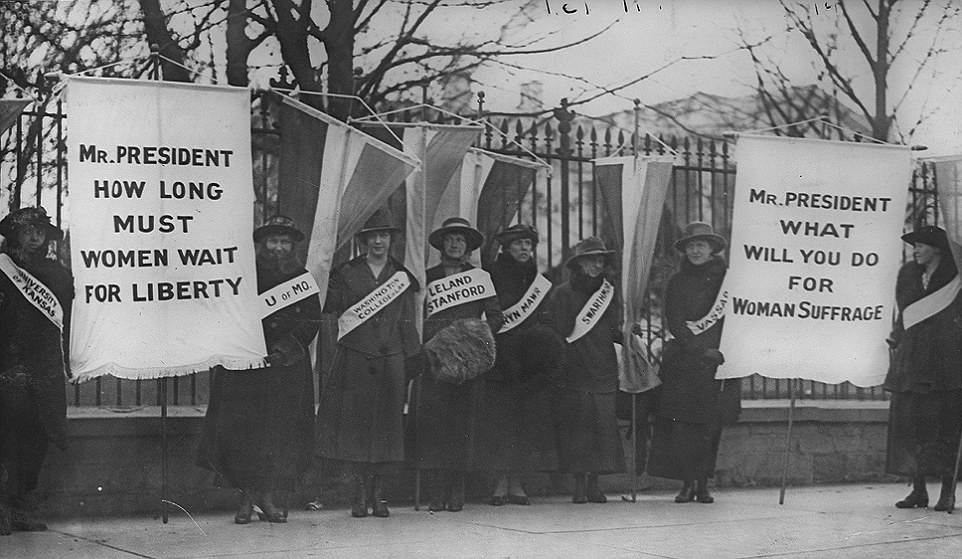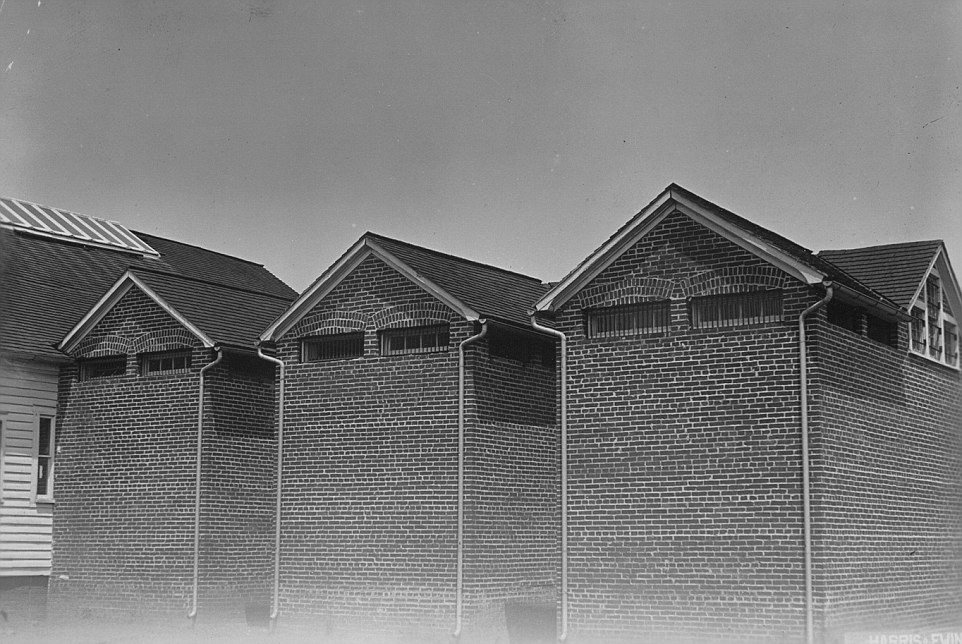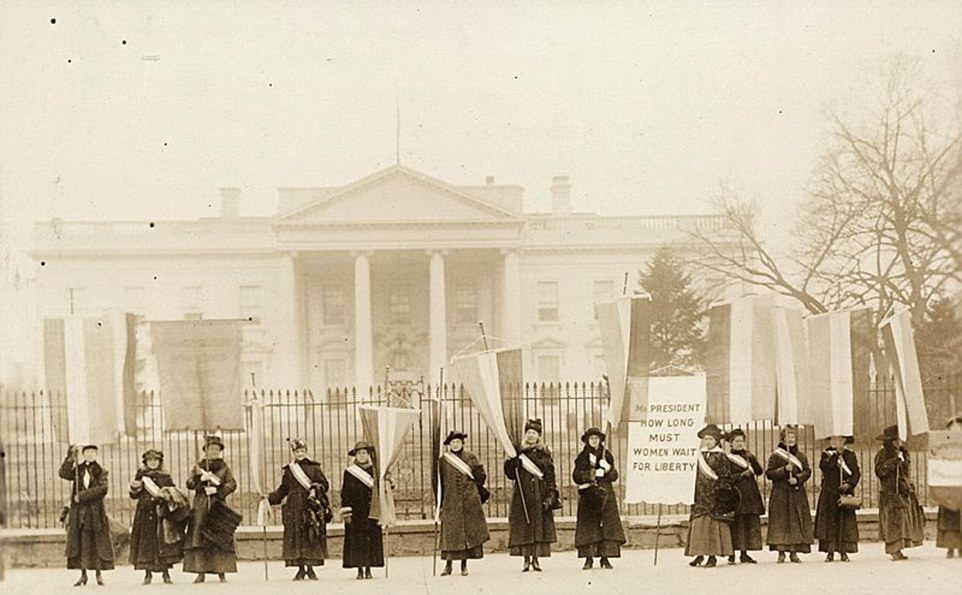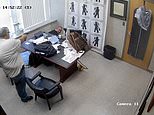Amazing never-before-seen photos reveal decaying U.S jail where brave White House suffragettes were tortured in 'Night of Terror'
- National Women's Party suffragettes were arrested while protesting for right to vote outside the White House in 1917
- They were taken to Lorton Reformatory in Virginia where guards attacked them at command of cruel superintendent
- Group's leader was chained up and left for the night and a 74-year-old was stabbed with the staff of broken banner
- They were released a few weeks later and the violence they suffered eventually led to U.S. women getting the vote
- Closed in 2001 after 91 years, these haunting pictures shows what is left of the crumbling jail that witnessed horrors
These are the decaying remains of a U.S. prison where 33 suffragettes were imprisoned and tortured for protesting for the right to vote.
Courageous protesters from the National Women's party were picketing the White House in November 1917 when 44 baton-wielding policemen arrested and dragged them to Lorton Reformatory, Virginia.
In what has become known as the 'Night of Terror', the guards chained the women, smashed their heads into iron beds and stabbed a 74-year-old between the eyes with the broken staff of her banner.
The shameful violence they suffered that night eventually led to the passing of the 19th Amendment which states the right to vote will not be denied 'by any State on account of sex'.
Scroll down for video

Crumbling: These crumbling remains are what is left of Lorton Reformatory, Virginia, the U.S. prison where 33 suffragettes were imprisoned and tortured for protesting for the right to vote in the early 20th Century

Hard labour: Suffragettes from the National Women's party picketing the White House in November 1917 were arrested and dragged to Lorton Reformatory (pictured) where they were housed in giant, brick dormitories and tortured


Suffering: In what has become known as the 'Night of Terror', the guards chained the women, smashed their heads into iron beds and stabbed a 74-year-old between the eyes with the broken staff of her banner

Haunting legacy: In the notorious 'Night of Terror' 33 suffragettes were locked up and tortured by Lorton's guards at the command of cruel superintendent W.H. Whittaker

Protest: Members of the National Women's Party (NWP) stood outside the White House (pictured) with signs addressed to new U.S. President Woodrow Wilson which read: 'Mr President how long must women wait for liberty'


Cruelty: Lucy Burns (left), NWP founder, had her hands chained to the cell bars above her head and was left there for the night. She was determined to expose the hypocrisy of President Wilson who wanted to make the world 'safe for democracy' when there was none at home

Trapped: The huge brick dormitories of Lorton Reformatory, which still stand today, were built by the inmates who were housed inside

Rusted: 91 years after it opened as a 'progressive' prison, Lorton was finally shut down as a jail in 2001 and has been stood rusting since

Eroded: Extraordinary photographs captured by Cindy Vasko show how the prison's pipes have rusted and the paint worn away over time

Manual labour: The U.S. government bought 3,200 acres of undeveloped land on the Occoquan River near Lorton and constructed the brickyards, fields, orchards and wharfs the detainees would be forced to work in

Run down: Lorton Reformatory, also known as the Occoquan Workhouse, was opened in 1910 as an experiment to see whether hard work in an open-air environment was a good deterrent for prisoners
Built as an 'industrial farm' in 1910, the Lorton Reformatory was an experiment to see if tough manual labour would deter violent drunks and domestic abusers from committing crimes, according to the Workhouse Prison Museum.
The U.S. government bought 3,200 acres of undeveloped land on the Occoquan River near Lorton and constructed the brickyards, fields, orchards and wharfs the detainees would be forced to work in.
The huge brick dormitories, which were built by the prisoners who lived in them, are one of the few structures which have survived almost a hundred years of erosion and decay.
A separate female workhouse, opened in 1912, was used to detain women who were found guilty of prostitution, disorderly conduct, drunkenness and eventually the suffragettes who risked their lives for women's rights.
The protests began shortly after President Woodrow Wilson began his second term in 1917, because they saw him as an enemy of the women's right movement.
Despite the threat of violence and prison sentences, and the ongoing World War, the National Women's Party (NWP) held round the clock demonstrations outside White House gates to demand the right to vote.
Its co-founders, Alice Paul and Lucy Burns, were determined to expose the hypocrisy of President Wilson who wanted to make the world 'safe for democracy' when there was none at home.
The arrests began in June. The women caught picketing were sent to the women's workhouse at Lorton where they were served rancid food, denied medical care and refused visitors because prison bosses saw them as traitors to America, WE News historians have said.
The most deplorable and humiliating punishments were reserved for the movement's 'ringleaders', Alice Paul, Lucy and another active NWP member, Dora Lewis.

Locked up: Women caught picketing were taken to the workhouse at Lorton where they were served rancid food and denied medical care

Struggle: The shameful violence they suffered that night eventually led to the passing of the 19th Amendment which states the right to vote will not be denied 'by any State on account of sex'

Determined: The National Women's Party began picketing the White House shortly after President Woodrow Wilson began his second term in 1917, because he refused to give women the vote


Punished: Minnie Hennessy (left) was sentenced to six months' at Occoquan Workhouse for picketing with a suffrage banner and Alice Paul (right), one of the co-founders of NWP, was force fed raw eggs when she attempted to go on hunger strike

Savagery: Some women picketing outside the White House were thrown into 'punishment cells' where they were beaten by cruel guards

Disintegrating: Many of the books and paperwork left at the prison has slowly been decaying ever since it was shut down in 2001

Decaying: All that remains inside Lorton Reformatory's crumbling walls is chipped paint, abandoned cells and rotting rodents (pictured)

Infested: Lorton Reformatory, which shut in 2001, is listed on the National Register of Historic Places

Violated: The suffragettes who were imprisoned in Lorton were served horrific food and denied access to their families or lawyers
On November 14, 1917, a date which has become known as the Night of Terror, 33 female protesters were taken to Lorton and brutally punished by the guards.
Most of the protesters were hurled into concrete 'punishment cells' where they were beaten by the guards, but Burns was handcuffed to bars above her head in a stress position and left there overnight.
They later stripped off her clothes and left her in the freezing cell with just a blanket, according to Charles A Mills' history book, Hidden History of Northern Virginia.
The guards threw Dora Lewis into a dark cell and smashed her head into an iron bed, which knocked her out. Lewis' cellmate suffered a heart attack because she thought she had died.
Paul tried to go on hunger strike to protest the brutality but the guards locked her in solitary confinement and force fed raw eggs through a tube down her throat.
The suffragettes were all released on November 27 and 28 and slowly, the stories of the violence and abuse they suffered began to creep into the newspapers.
As news of their torturous sentences spread, sympathy and support of their movement around the country grew. In March 1918, their arrests, trials and punishments were judged to be unconstitutional and the 19th Amendment which gave women the right to vote was declared in 1919.
Women were allowed to vote in the November 1920 national election. Their struggle was eventually adapted into the 2004 Hollywood drama, Iron Jawed Angels, starring Hilary Swank as Paul and Frances O'Connor as Burns.

Honoured: The NWP's struggle for female rights was eventually adapted into the 2004 Hollywood drama, Iron Jawed Angels (pictured)

Star cast: The Golden Globe Winning film starred Hilary Swank (centre) as Alice Paul and Frances O'Connor as Burns

'Lead, follow or get out of the way': Iron Jawed Angels, which was loved by critics and audiences alike, documented the NWP's pursuit of equal rights for women in the face of brutality and persecution

Freedom at last: The suffragettes were all released from Lorton on November 27 and 28 and slowly, the stories of the violence and abuse they suffered began to creep into the media

Lights out: These haunting photographs of Lorton Reformatory, used to hold 20th Century suffragettes, were taken by Cindy Vasko

Empty: Built as an 'industrial farm' in 1910, the Lorton Reformatory (pictured) was an experiment to see if tough manual labour would deter violent drunks and domestic abusers from crime

On the notorious 'Night of Terror' most of the arrested suffragettes were hurled into concrete 'punishment cells' but the most brutal treatment was reserved for the NWP's 'ringleaders' Alice Paul and Lucy Burns

Victory: In March 1918, their arrests, trials and punishments were judged to be unconstitutional and women were allowed to vote in the November 1920 national election
Most of the photography for the the Golden Globe winning film - loved by audiences and critics alike - was done in the state of Virginia.
More than 91 years after it opened as a 'progressive' reformatory, Lorton was finally shut down as a prison in 2001, the Washington Post reported.
Its final 19 inmates crept through its rusted, automatic gate and boarded a bus to DC jail. They were held there until they were eventually handed over to the US Bureau of Prisons and moved to jails across the country.
The haunting photographs of a crumbling, empty Lorton Reformatory were captured by urbex photographer Cindy Vasko.
All that remains of this once brutal prison - once used to stop courageous suffragettes fighting for freedom - is chipped paint, rusted iron bars and decaying rodents.
Most watched News videos
- Brutal moment Ukrainian soldier loses knife battle to Russian fighter
- A Kamala flub, a snub, and JD Vance snickers: Senate awkward moments
- Influencer reveals his incredible 384lb weight-loss during TV show
- Dog gets zoomies in back of moving car in NC
- Drone footage captures deadly New Years fireworks blast in Honolulu
- Lorry bursts into flames sparking motorway mayhem on the M40
- 'No!': Nigel Farage says he won't let Tommy Robinson join Reform UK
- Drone footage captures deadly New Years fireworks blast in Honolulu
- Edinburgh and its surroundings covered in snow amid cold snap
- UK set for icy and snowy weekend as Met issues Amber weather warning
- Missouri man sends bowling ball crashing through alley ceiling
- Children of sworn in senators show support for Kamala Harris









































